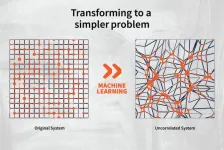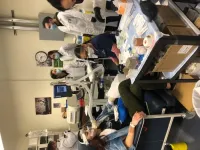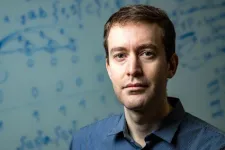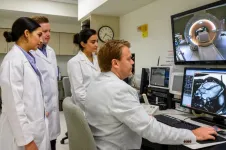(Press-News.org) A recent study published in Analytical Science Journal conducted by Schmid College of Science and Technology Professor Rosalee Hellberg and students Calin Harris, Diane Kim, Miranda Miranda and Chevon Jordan, reveal that some supplement companies may mislead customers with unproven health claims and undeclared ingredients.
The researchers focused on supplements that have been associated with the purported treatment or prevention of COVID-19 and other respiratory illnesses. During the pandemic, the use of dietary supplements skyrocketed throughout the world. “There was a big spike in purchase and use of these types of supplements during the pandemic,” Hellberg said. “Whenever there’s an increase in demand, there’s also an increased chance for fraud to occur.”
The Chapman team collected 54 supplements containing Ayurvedic herbs, which refers to alternative medicine originating from India. They specifically chose herbs that had been used for the purported treatment of COVID-19. These included ashwagandha, cinnamon, ginger, turmeric, tulsi, vacha, amla, guduchi and tribulus. All products were purchased online and from local retailers in Orange and Los Angeles counties, CA.
The researchers analyzed whether they could use DNA barcoding techniques to identify plant species in supplements to determine the authenticity of the products. DNA barcoding is a method that allows scientists to use a short section of a DNA sequence to identify the species of an organism.
The results of the study revealed several concerns indicating a need for increased scrutiny of these products. In 60% of the products, the researchers did not detect the expected ingredient. However, Hellberg did not explicitly pin these results on fraud. The DNA barcoding method, because it’s being utilized in a novel way, may have a limited ability to detect degraded DNA. Therefore, a negative result does not necessarily prove the absence of the species in the product.
Another limitation of the DNA barcoding method is it doesn’t reveal the quantity of the detected species of ingredients. Additional research would be necessary to verify the amount of each, Hellberg said.
“If the ingredients were present at a higher amount, that is where the concerns can arise,” Hellberg said. “Also, any time you're detecting things that aren't on the label, that can indicate some quality control issues. That could also suggest that there are other health risks going on or maybe things aren't being handled properly.”
The researchers also uncovered 19 products with undeclared plant species. Rice and a few other materials were used as common fillers. They also identified other Ayurvedic herbs that were not listed on labels.
“So these could be used in a fraudulent manner,” Hellberg said. “Instead of having 100% of the declared species on the label, some manufacturers might mix in filler because it’s cheaper.
With undeclared species and ingredients in supplements, consumers could ingest substances that cause allergic reactions and other health risks. However, it isn’t clear from the study how high the risk would be because the researchers were not able to detect the amount of each ingredient.
“If the ingredients were present at a higher amount, that is where the concerns can arise,” Hellberg said. “Also, any time you're detecting things that aren't on the label, that can indicate some quality control issues. That could also suggest that there are other health risks going on or maybe things aren't being handled properly.”
END
What’s actually in your supplements? Chapman University researchers detect hidden ingredients and questionable claims in supplements
2024-05-14
ELSE PRESS RELEASES FROM THIS DATE:
STRIVE project to study ozone, atmospheric layers among finalists for next-generation NASA satellite
2024-05-14
A project led by the University of Washington to better understand our atmosphere’s complexity is a finalist for NASA’s next generation of Earth-observing satellites. The space agency this week announced the projects that will each receive $5 million to advance to the next stage and conduct a one-year concept study.
STRIVE seeks to better understand the troposphere that we inhabit and the stratosphere above it, where the ozone layer is, as well as the interface where these two layers meet. That interface, about 6 miles (10 kilometers) above the surface, is where important ...
Simulating diffusion using 'kinosons' and machine learning
2024-05-14
Researchers from the University of Illinois Urbana-Champaign have recast diffusion in multicomponent alloys as a sum of individual contributions, called “kinosons.” Using machine learning to compute the statistical distribution of the individual contributions, they were able to model the alloy and calculate its diffusivity orders of magnitude more efficiently than computing whole trajectories. This work was recently published in the journal Physical Review Letters.
“We found a much more efficient way to calculate diffusion in solids, and at the same time, we learned more ...
Far from toxic, lactate rivals glucose as body's major fuel after a carbohydrate meal
2024-05-14
As a student competing in track and field at his Parlier high school, Robert Leija was obsessed with how to improve his performance and, in particular, prevent the buildup of lactic acid in his muscles during training. Like many athletes, he blamed it for the performance fatigue and muscle soreness he experienced after intense workouts.
But as a kinesiology student at Fresno State, he was handed an out-of-print textbook that told him he had it all wrong. Lactate wasn't a danger sign that athletes had depleted their body's supply of oxygen, but likely a normal product of the metabolic activity required to fuel the muscles during sustained exercise.
Now, as a graduate student ...
AI for more caring institutions
2024-05-14
More and more public services — such as affordable housing, public school matching and child welfare — are relying on algorithms to make decisions and allocate resources. So far, much of the work that has gone into designing these systems has focused on workers’ experiences using them or communities’ perceptions of them.
But what about the actual impact of these programs have on people, especially when the decisions the systems make lead to denial of services? Can you design algorithms to help people make sense of and ...
Astronomers spot a giant planet that is as light as cotton candy
2024-05-14
Astronomers at MIT, the University of Liège in Belgium, and elsewhere have discovered a huge, fluffy oddball of a planet orbiting a distant star in our Milky Way galaxy. The discovery, reported today in the journal Nature Astronomy, is a promising key to the mystery of how such giant, super-light planets form.
The new planet, named WASP-193b, appears to dwarf Jupiter in size, yet it is a fraction of its density. The scientists found that the gas giant is 50 percent bigger than Jupiter, and about a tenth as dense — an extremely low density, comparable to that of cotton candy.
WASP-193b is the second lightest planet discovered to date, ...
Sleep experts to convene in Houston for SLEEP 2024 annual meeting
2024-05-14
DARIEN, IL – Leading sleep and circadian scientists, sleep clinicians, and industry innovators will gather June 2-5 in Houston at SLEEP 2024, the 38th annual meeting of the Associated Professional Sleep Societies, LLC. Thousands of sleep professionals will connect, explore, and grow at the world’s premier clinical and scientific sleep meeting, held jointly by the American Academy of Sleep Medicine and the Sleep Research Society.
“Every year, SLEEP brings together the world’s ...
Rice’s Mamouras wins NSF CAREER Award
2024-05-14
HOUSTON – (May 14, 2024) – As the Internet of Things (IoT) grows larger and more complex, it becomes increasingly difficult to develop applications.
“A common approach to this problem is to move data from the sensing devices to a central location, such as the cloud, for processing,” said Konstantinos Mamouras, assistant professor of computer science at Rice University. “But this centralized approach underutilizes the small IoT devices at the edge of the network and can overwhelm it due to the large movement of data.”
With his five-year, $547,555 National Science Foundation CAREER Award, Mamouras aims to decentralize the IoT, relieve network congestion and ...
ISS National Lab announces up to $750,000 in funding for technology development in low Earth orbit
2024-05-14
KENNEDY SPACE CENTER (FL), May 14, 2024 – The International Space Station (ISS) National Laboratory is soliciting flight concepts for technology development that would utilize the space-based environment of the orbiting laboratory. This solicitation, “Technology Development and Applied Research Leveraging the ISS National Lab,” is open to a broad range of technology areas, including chemical and material synthesis in space, translational medicine, in-space edge computing, and ISAM (in-space servicing, assembly, and manufacturing). ...
Counterfeit coins can be detected more easily thanks to a novel approach developed at Concordia
2024-05-14
Metal coins may be just about the oldest medium of exchange still in use today, but ensuring their worth requires some of the most state-of-the-art technology available. Counterfeit coins remain a threat to global currencies, with malicious actors flooding markets with fakes. European police broke up a Spain-based criminal ring in late April, demonstrating the issue’s ongoing urgency.
However, no counterfeit is completely detection-proof, no matter how genuine it appears. There are always some tell-tale signals of forgery, even if they are not ...
Professors elected to Academy of Distinguished Scholars
2024-05-14
The University of Texas at Arlington has elected two longtime professors to the Academy of Distinguished Scholars, considered the University’s most prestigious research and scholarship honor.
Ramon Lopez, professor of physics, and Michael D. Nelson, associate professor of kinesiology, are being recognized for their sustained and significant contributions to research and creativity.
“Members of the Academy of Distinguished Scholars exemplify UTA’s commitment to quality research and creative activity,” said Kate C. Miller, vice president of research and innovation. “Mike and Ramon have both ...





